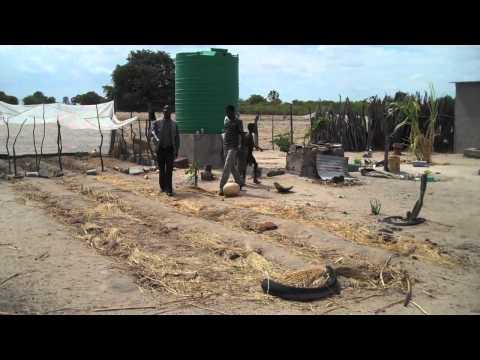Community-Based Adaptation: Namibia
Introduction
Namibia faces significant climate change risks, including increased aridity and heightened climate variability. Projected impacts include:
- Increased production risks to smallholder agriculture and pastoralism
- Increasing erosion risks
- Increasing risk of flood
- Risks to climate sensitive biodiversity, with impacts on the ecotourism sector
The CBA Namibia portfolio consists of two (2) projects:
- Adjusting Agricultural Practices to Reduce Climate Change Risk in Omusati Region
- Harnessing Coping Strategies via a Holistic Approach for Community Adaptation to Climate Change
Community-Based Adaptation activities in
All CBA projects involve non-governmental organizations (NGO) at the local and national levels. The UN Volunteers is a project partner in seven (7) out of the ten (10) CBA countries: Bolivia, Guatemala, Jamaica, Morocco, Niger, Namibia, and Samoa. In addition to the Adaptation & Volunteerism Specialist overseeing the seven (7) countries, an International UNV officer in Namibia is fully dedicated to the CBA projects at the local level. The partnership began in June 2009.
The Government of Japan co-finances the UNDP/GEF CBA projects in Niger and Namibia. This partnership began in early 2009.
* Namibia is one of ten (10) countries implementing projects as part of UNDP's "Community-Based Adaptation" programme. *




Project details
Namibia’s Initial National Communication to the UNFCCC indicates significant vulnerability to climate change impacts. With an economy strongly dependent on natural resources such as agriculture, water, fisheries and wildlife, and nature-based tourism, predicted impacts can have severe repercussions for economic development and sustainable livelihoods.
Under the current climate, Namibia is already subject to frequent and persistent dry periods, as well as erratic rainfall, and the country is considered to be the most arid country in sub-Saharan Africa. According to international climate predictions, the impacts of climate change will exacerbate the already prevailing adverse climatic conditions – increasing aridity as well as making the climate increasingly variable. A large percentage of Namibia’s population relies on subsistence and small-holder ranching and in some areas agriculture (about 70% of the population are subsistence farmers), activities which are highly vulnerable to climate change impacts. To safeguard these livelihoods, relevant responses to climate change have to be designed and implemented at all levels. The Community-Based Adaptation programme in Namibia will pilot the community-based component of these adaptation activities.
Projections for Namibia and the southern African region suggest significant vulnerability to the impacts of climate change (IPCC, 2001 and 2007), and recent studies suggest that by 2050, temperatures and rainfall over southern Africa will be 2 – 4°C higher and 10 – 20% less than the 1961-90 baseline respectively. According to the IPCC’s fourth assessment report, all of Africa is very likely to warm during this century. The warming is very likely to be larger than the global, annual mean warming throughout the continent and in all seasons, with drier subtropical regions warming more than the moister tropics. Rainfall in southern Africa is likely to decrease.
Although at present flood and drought preparedness is being advocated as a “normal” risk management strategy, it is obvious that Namibians have to start planning and managing for the long-term climate changes that will probably occur in the future.The vulnerability assessment of the Second National Communication (SNC) to the UNFCCC currently underway, but the vulnerability assessment suggests that climate trends need to be assessed on a finer scale. The direct effects of climate change could potentially be felt in sectors such as water; agriculture; fisheries; ecosystems, biodiversity and tourism; coastal zones; health; and energy.
Therefore, Namibia's Community-Based Adaptation project interventions seek to increase the resilience of communities and ecosystems to the impacts of climate change by building capacity at the local level to integrate climate change concerns into sustainable community-based management of natural resources. The agriculture sector and natural resources sectors are targeted for project intervention.
- Community
- United Nations Development Programme (UNDP)
- Global Environment Facility (GEF)
- The GEF Small Grants Programme
- UN Volunteers
News
Key results and output
The objective adopted by Namibia’s CBA Country Programme Strategy is to foster capacity among natural resource-dependent communities to sustainably manage resources in the face of climate change.
This will be achieved through the following outcomes:
- awareness built regarding climate change risks and adaptation options for natural resource users;
- access to climate change and scenario information integrated into sustainable resource management activities;
- and access to alternative resources enhanced to enable adaptation to climate change while reducing climate change stresses on climate sensitive biodiversity, soils and ecosystems.
Impact Indicators:
- Number of stakeholders at community level (e.g. businesses, community representatives, CBOs, NGOs) engaged by project and provided with training in climate change risk management and scenario planning.
- Population covered by awareness building programmes to increase understanding of risks associated with climate change among general public and key stakeholder groups.
- Increase in awareness of climate change related risks to natural resources
- Percentage change in natural resource dependent population with access to alternative or supplementary livelihood options
Reports & publications
Videos & multimedia
Monitoring & evaluation
Monitoring and evaluation for community-based adaptation is a new field, and the CBA project is piloting innovative approaches to evaluating the success of locally-driven adaptation projects, and generating lessons to inform ongoing practice.
Key considerations in M&E for CBA include:
- Grounding M&E in the local context: M&E for CBA should avoid overly rigid frameworks, recognizing community heterogeneity and maintaining local relevance
- Capturing global lessons from local projects: CBA projects are highly contextualized, but lessons generated should be relevant to stakeholders globally
- Incorporation of both quantitative and qualitative indicators: to ground projects in tangible changes that can be objectively evaluated, and to capture lessons and case studies for global dissemination
To these ends, the CBA project uses three indicator systems: the Vulnerability Reduction Assessment, the Small Grants Programme Impact Assessment System, and the UNDP Climate Change Adaptation Indicator Framework.
The Vulnerability Reduction Assessment (VRA)
The VRA is a question-based approach with the following aims:
- To make M&E responsive to community priorities
- To use M&E to make projects more accountable to local priorities
- To make M&E capture community ideas and local knowledge
- To gather community-level feedback to guide ongoing project management
- To generate qualitative information
- To capture lessons on specific issues within community-based adaptation
- To generate case studies highlighting adaptation projects
The VRA follows UNDP's Adaptation Policy Framework, and is measured in a series of meetings with local community stakeholders. In these meetings, locally-tailored questions based on standard VRA questions/indicators are posed, and the community assigns a numerical score on a 1-10 scale for each question. Progress is evaluated through changes in scores over the course of implementation, as well as through qualitative data collected in community discussions surrounding the exercise.
UNDP has developed a Users Guide to the VRA (Espanol) (Francais) as a tool to assist practitioners to conceptualize and execute VRA measurements in the context of CBA projects.
The SGP Impact Assessment System (IAS)
The CBA, being a project of the GEF Strategic Priority on Adaptation, aims to increase the resilience of ecosystems and communities to the impacts of climate change, generating global environmental benefits, and increasing their resilience in the face of climate change impacts. To this end, the CBA projects use the SGP's impact assessment system for monitoring achievements in GEF focal areas (focusing primarily on biodiversity and sustainable land management).
The IAS is composed of a number of quantitative indicators which track biophysical ecosystem indicators, as well as policy impact, capacity development and awareness-building.
UNDP Climate Change Adaptation Indicator Framework
CBA projects also track quantitative indicators from UNDP's adaptation indicator framework, corresponding to the thematic area on natural resources management. More information on UNDP's indicator framework can be found on the UNDP climate change adaptation monitoring and evaluation website.
* This description applies to all projects implemented through UNDP's Community-Based Adaptation programme. Specific details on this project's M&E will be included here as they become available. *
Links
Newsfeed
Contacts
- UNDPCBA Project Management Unit
- GEF Small Grants ProgrammeMr. Nickey Lazarus GasebNational Coordinator (Namibia)
- UN VolunteersMs. Sion ShifaNational UN Volunteer

